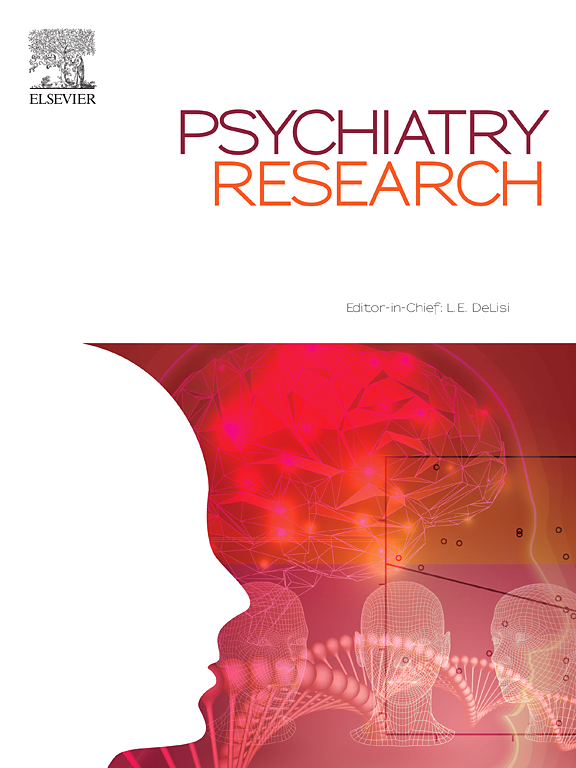The decision to help-seek within 24-hours following a suicide attempt: Rate and proximal correlates within an emergency department sample
IF 3.9
2区 医学
Q1 PSYCHIATRY
引用次数: 0
Abstract
There is a critical need to identify proximal factors associated with help-seeking following a suicide attempt (SA; i.e., attempt to kill oneself). Many individuals receive emergency department care following a SA; however, little is known about factors distinguishing individuals who present to the emergency department voluntarily (i.e., played an active role in presentation through their own action to obtain help or through requesting help) and those who do not (i.e., brought to the emergency department due to no action of their own) following a SA, which could improve suicide prevention efforts. It was hypothesized that using a poisoning SA method and experiencing social support would increase the likelihood of help-seeking following SA. This study utilized electronic health record data for 553 emergency department patients (Mage = 37.94 [SD = 15.67], 53.30 % female, 94.40 % white) presenting within 24-hours after SA during a two and a half year period across six hospitals within a rural healthcare system. Within 24-hours of SA, 34.4 % engaged in help-seeking. The use of a poisoning SA method and a diagnosis of borderline personality disorder increased the likelihood of help-seeking, whereas a diagnosis of bipolar disorder and being in a romantic relationship decreased the likelihood. Results can inform suicide prevention initiatives to promote help-seeking immediately following SA, a critical period that may represent the last opportunity for self-intervention prior to the occurrence of lasting serious injury or death by suicide.
自杀未遂后24小时内寻求帮助的决定:急诊科样本中的比率和近端相关性
迫切需要确定与自杀未遂后寻求帮助相关的近端因素(SA;例如,企图自杀)。许多人在SA后接受急诊治疗;然而,对于在SA后自愿到急诊科就诊的个体(即通过自己的行动获得帮助或通过请求帮助在就诊中发挥积极作用)和非自愿(即由于自己没有采取行动而被带到急诊科)之间的区别因素知之甚少,这可以改善自杀预防工作。假设使用中毒SA方法和经历社会支持会增加SA后寻求帮助的可能性。本研究利用了553名急诊科患者的电子健康记录数据(性别= 37.94 [SD = 15.67], 53.30%女性,94.40%白人),这些患者在两年半的时间内出现在农村医疗保健系统内的6家医院的SA后24小时内。在24小时内,34.4%的人寻求过帮助。使用中毒SA方法和诊断为边缘型人格障碍增加了寻求帮助的可能性,而诊断为双相情感障碍和处于恋爱关系中则降低了寻求帮助的可能性。研究结果可以为自杀预防措施提供信息,以促进自杀后立即寻求帮助,这一关键时期可能是自杀造成持久严重伤害或死亡之前进行自我干预的最后机会。
本文章由计算机程序翻译,如有差异,请以英文原文为准。
求助全文
约1分钟内获得全文
求助全文
来源期刊

Psychiatry Research
医学-精神病学
CiteScore
17.40
自引率
1.80%
发文量
527
审稿时长
57 days
期刊介绍:
Psychiatry Research offers swift publication of comprehensive research reports and reviews within the field of psychiatry.
The scope of the journal encompasses:
Biochemical, physiological, neuroanatomic, genetic, neurocognitive, and psychosocial determinants of psychiatric disorders.
Diagnostic assessments of psychiatric disorders.
Evaluations that pursue hypotheses about the cause or causes of psychiatric diseases.
Evaluations of pharmacologic and non-pharmacologic psychiatric treatments.
Basic neuroscience studies related to animal or neurochemical models for psychiatric disorders.
Methodological advances, such as instrumentation, clinical scales, and assays directly applicable to psychiatric research.
 求助内容:
求助内容: 应助结果提醒方式:
应助结果提醒方式:


